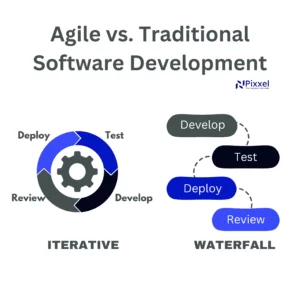In today’s fast-paced world, being flexible and adaptable is key, especially in tailored software development. Agile software development has become one of the most effective ways to manage software projects efficiently, flexibly, and with a focus on the customer.
In this blog post, we’ll explore what agile software development is all about, the different methods it includes, and how to implement Agile successfully within a team. We’ll also look at common challenges and practical solutions.
If you’re interested in the costs of software development, be sure to check out this blog post.
Key Takeaways
- Quick Definition: Agile software development is a flexible and step-by-step approach where work is divided into short cycles called sprints. It is based on 4 values and 12 principles outlined in the Agile Manifesto.
- Agile promotes flexible and iterative development that responds to changes.
- Close collaboration within the team and with the customer is central.
- Agile encourages constant improvement and adaptation to new situations.
- The Scrum Master plays a crucial role in supporting the team and guiding the process.
What Is Agile Software Development?
Agile development is a method where work is done in small, manageable steps called iterations or sprints.
The goal is to respond flexibly to changes and build software piece by piece. Instead of planning everything in detail upfront, Agile focuses on delivering results quickly and gathering continuous feedback.
This approach helps tailor the software precisely to the customer’s needs.
The 4 Values and 12 Principles of the Agile Manifesto
Agile is built on four core values:
- Individuals and interactions are more important than processes and tools.
- Working software is more important than comprehensive documentation.
- Customer collaboration is more important than contract negotiation.
- Responding to change is more important than following a plan.
There are also twelve principles that support these values:
- Aim for customer satisfaction by delivering functional software early and continuously.
- Be open to changing requirements, even late in the project, to increase product value.
- Deliver working software regularly, preferably in short time frames, to maintain momentum and get quick feedback.
- Encourage close, daily collaboration between business people and developers for alignment and quick decisions.
- Build projects around motivated individuals by providing them with the environment and support they need.
- Use face-to-face conversations as the most effective form of communication to ensure clarity and understanding.
- Measure progress mainly through the consistent delivery of working software.
- Promote sustainable development by maintaining a constant, manageable work pace for the team.
- Focus on technical excellence and good design to enhance agility.
- Keep things simple by eliminating unnecessary tasks and minimizing unfinished work.
- Empower teams to organize themselves to make the best use of their collective skills and creativity.
- Regularly reflect on team performance and adjust processes and practices to improve continuously.
Why Choose Agile Software Development?
Benefits of Agile Development
Agile offers many advantages:
- Faster time to market: Software can be released in stages, allowing customers to benefit from new features early on.
- Flexibility: Agile adapts to changes at any point during development.
- High quality: Frequent testing and feedback loops continuously improve the software’s quality.
- Better collaboration: Agile encourages open communication between team members and with the customer, leading to better results.
Drawbacks of Agile Development
Despite its benefits, there are some challenges:
- Requires discipline: Agile teams need to be well-organized and self-motivated to work effectively.
- Potential uncertainty: Since planning happens step by step, the exact end goals might be unclear at times.
- Depends on continuous feedback: Without regular input from the customer, it can be hard to stay on the right track.
Methods of Agile Software Development
Overview of Agile Methods
There are various methods within agile software development, all based on Agile’s core principles. The most well-known include Scrum, Kanban, and Extreme Programming (XP). Each offers different ways to organize work and ensure effective teamwork.
Scrum Framework
Scrum is one of the most widely used agile methods. It involves working in sprints that usually last two to four weeks. A Scrum team includes a Product Owner, a Scrum Master, and a development team. The Product Owner sets priorities, the Scrum Master ensures efficient workflow, and the development team carries out the work.
Kanban Method
Kanban focuses on visualizing work and maintaining a steady flow of tasks. Tasks are displayed on a Kanban board divided into stages like “To Do,” “In Progress,” and “Done.” This method helps teams identify bottlenecks and optimize their workflow.
Extreme Programming (XP)
Extreme Programming emphasizes technical excellence and constant improvement. Practices include frequent testing, continuous integration, and close collaboration between developers and customers. XP is especially useful for projects that require high quality and quick adaptability.
Popular Agile Techniques
Alongside the main methods, several techniques are commonly used in agile projects:
- Daily Stand-ups: Short daily meetings to discuss the current status of work.
- Pair Programming: Two developers work together at one computer to write code and provide immediate feedback.
- Retrospectives: Regular meetings to discuss what went well and what can be improved.
When to Use Agile and When to Use Traditional Waterfall Development?
Choosing between the Waterfall model and an agile method like Scrum depends heavily on the project’s specific nature. There’s no one-size-fits-all solution.
Some projects benefit greatly from an agile approach, especially when flexibility and quick adjustments are needed. Others might be better suited for traditional, step-by-step development. It’s important to carefully consider the project’s requirements, the customer’s expectations, and the team’s dynamics before deciding on the right method.
Traditional Project Management
Traditional project management, also known as the Waterfall model, follows a sequential process. Each phase must be completed before the next one begins. This provides clear structure but can be inflexible when requirements change.
Comparing Agile and Traditional Methods
Traditional project management relies on strict plans and defined phases, while Agile is flexible and iterative. Agile methods allow for gradual development and adjustments as needed. Traditional methods offer more planning certainty but are less adaptable.
How to Implement Agile in a Team?
Setting Up Agile Teams
An agile team usually consists of five to nine people with different skills. The team organizes itself and works together towards a common goal. It’s important for the team to have a clear structure but still be flexible enough to adapt to changes.
Agile Practices and Tools
There are many useful tools and practices that support agile work:
- User Stories: Simple, brief descriptions of what the user wants.
- Backlog: A list of all tasks that need to be completed.
- Burn-down Chart: A graph showing how much work remains to be done.
What Challenges Arise When Introducing Agile?
Common Implementation Issues
Introducing Agile can come with several challenges:
- Resistance to change: Team members used to traditional methods may struggle to adapt to Agile.
- Unclear roles: Confusion can arise if responsibilities aren’t clearly defined.
- Lack of support: Without proper backing from leadership, implementing Agile can be difficult.
Overcoming Resistance to Change
To overcome resistance, it’s important to train the team well and clearly communicate the benefits of Agile. Introducing Agile gradually and celebrating successes can also help motivate the team.
How Does Agile Improve Collaboration and Communication?
Team Collaboration Techniques
Agile enhances teamwork through various techniques:
- Pair Programming: Developers work together at one computer to avoid errors and learn from each other.
- Retrospectives: Regular meetings to reflect on collaboration and make improvements.
Communication Practices in Agile
Communication in Agile is open and transparent. Information is shared through brief meetings and direct conversations instead of long reports. This approach helps prevent misunderstandings and resolves issues quickly.
What Is the Role of a Scrum Master in Agile?
Responsibilities of a Scrum Master
The Scrum Master is a key figure in the Scrum team. They ensure that the team works efficiently and follows Scrum principles. The Scrum Master leads meetings, solves problems, and helps the team continually improve.
Essential Skills for a Scrum Master
A good Scrum Master should have strong communication skills and be able to resolve conflicts. They need to motivate the team and have a deep understanding of Agile and its practices.
Practical Example: Success Story of Strassl Schaider – Customized Order Management Software
Strassl Schaider, a well-known hairdressing company in Austria, faced a specific challenge: better managing orders across multiple locations.
We worked with Strassl Schaider to develop software tailored to their needs. This software brings all suppliers and locations together in an easy-to-use application. The result? More efficient inventory management and optimized logistics for over 50 locations with nearly 500 employees.
An agile development process was at the heart of this project. The team included a system architect, developers, designers, and a project manager. They worked in short phases, or sprints, each lasting two weeks. This approach allowed for regular feedback from Strassl Schaider and continuous improvement of the software.
Are you looking for a software company? We’re happy to provide clear and transparent information about your project and plans.





